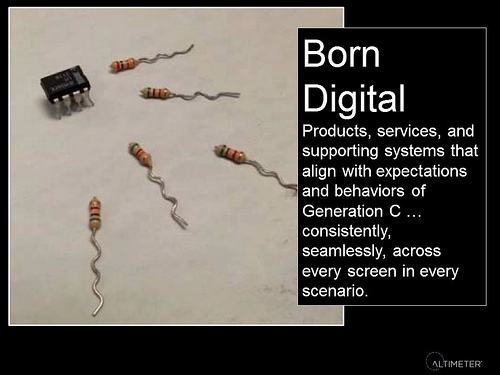Marketers, educators, parents, it seems that almost anyone in the Generation X or Boomer demographic is scratching their heads trying to figure out Generation Y aka the Millennial. After all, it’s the first generation to seemingly possess digital prowess as part of their DNA. And, it’s the first generation to receive both a birth certificate and a social profile or presence upon delivery into this world.
A study published in 2011 by security company AVG and Research Now surveyed 2,200 mothers from around the world and found that 81% of children under the age of two currently have some type of digital footprint. 92% of U.S. children have an online presence created for them by the time they are 2 years old. In many cases, a digital presence is born before the child, with sonograms (23%) actively published and shared on social networks and blogs.
With every day that passes, Gen Y becomes far more important to the economy than we can realize. Yet the gap between how Gen Y communicates and connects and how businesses, educators, governments, et al. approach them is only widening. I often wonder whether or not we are simply trying to talk to ourselves in our approach when in reality, we are talking to strangers. This is important as without understanding what’s important to them and why, without learning their behavior or decision making cycles, or without empathy, we cannot reverse engineer nor create a meaningful and engaging journey. We cannot create bridges from where they are to us nor can we expect them to use them.
How well do you know Gen Y?
Here are some interesting points for discovery that get us thinking beyond what we think we know today:
59% update their social status in class.
29% find love through Facebook while 33% are dumped via TXT or Wall posts (SRS) – abbreviation for seriously
Millennials watch TV with two or more electronic devices
Only 11% define having a lot of money as a definition of success
Gen-Y will form 75% of the workforce by 2025 and are actively shaping corporate culture and expectations.
Only 7% of Gen-Y works for a Fortune 500 company as startups dominate the workforce for this demographic. Gen-Y expects larger organizations to hear their voice and recognize their contributions…increasing the need for an intrapreneurial culture.
Millennials trust strangers over friends and family. They lean on UGC for purchases.
They are 3x as likely to follow a brand over a family member in social networks
66% will look up a store if they see a friend check-in
73% have earned and used virtual currency
Gen-Y believes that other consumers care more about their opinions than companies do – that’s why they share their opinions online.
Gen-Y’ers are more connected on Facebook than average users managing a social graph of 696 Facebook friends versus 140.
If knowledge is the key to enlightenment, then perception and imagination are windows to engagement and relevance. We can learn all we want about Millennials, but if we can’t translate that into meaning or substance, we will continue to miss opportunities to build lasting relationships.

The gap isn’t just widening because of the growing pervasiveness of Millennials in our economy. As I introduced in The End of Business as Usual, anyone who places increasing emphasis on technology as part of their daily routine, in many ways, their behavior mimics that of Millennials and as a result, they prove elusive or immune to traditional marketing and service. In the book, I refer to this class of consumer as “the Connected Customer” and their behavior is noticeably dissimilar to that of their traditional counterparts. The connected customer is the stranger you must get to know as in comparison to the customers of the past, this group is only growing and it’s traversing demographics. As such, the connected customer becomes what we can or should now refer to as Generation C where the “C” represents connectedness.
Introducing Gen-C
No longer can we blame it on the youth. We must blame, if anything, the disruption of technology. Nowadays, age ain’t nothing but a number. It is how people embrace technology, from social networks, VoIP phone service, smartphones to intelligent appliances, that contributes to the digital lifestyle that is now synonymous with Gen-C.

A recent study published by Nielsen brings Generation C into light. In just one image, we can begin to comprehend the disruption of digital revolution on society. Call it the social economy. Call it the mobile or the app economy. Call it the connected economy. Whatever we call it, this incredible transformation that we’re witnessing, is indeed nothing short of a digital revolution.
The Last 10 Years

274 million American have Internet Access, which is more than double that of 2000.
81 billion minutes spent on social networks and blogs
64% of all mobile phone time is spent on apps.
42% of tablet owners use them daily while watching TV.
For the first time, the numbers of laptops have surpassed desktops within TV homes.
Women Rule Gen-C

In 2009, I discovered that in social media, women rule. As you can see in Nielsen’s report, women too rule Gen-C. Specifically, they rule social media and online video and TV viewership. With smartphones, men and women are tied in adoption. With tablets however, men rule.
Gen-C, By the Numbers
If you compare Nielsen’s graphic with that of IBM’s research on Social CRM, you can appreciate the full dimension of Gen-C as every demographic, in their own way, is adopting disruptive technology. And, it’s only becoming greater.

Platforms for Digital Access
Every digital experience has its springboard. Whether it’s a PC, tablet, smartphone, and soon, a connected TV, our ability to every platform unifies the 5-C’s of engagement, create, connect, consume, communicate, and contribute.

274.2 million Americans have Internet access
169.6 million visit social networks and blogs
165.9 million people watch video on a PC

70% of time using tablets is spent while at home versus 30% on the go
Content accessed on tablets is 1) News at 39%, 2) Sports at 34%, and Books at 31%

On smartphones, 117.6 million visit the Internet
App usage peaks at 5 p.m. among adults
Smartphones are used by 44% of all mobile subscribers in the U.S.
Video Continues to Kill the Radio Star: Engagement is Cross Platform
Nielsen found that consumers increased their online video consumption by 7% from Q3 2010 to Q3 2011. As you can see in theimage below, online and mobile video consumption is significant.

Younger demographics watch less TV and watch video more online and on mobile devices.
With each generation, TV viewership rises with age.
Connected Customers are Multitaskers

Nielsen also shared the engagement habits and online activity of connected customers. As consumers watch a program, they are online with 1) 57% checking email, 2) 44% surfing the web, and 3) another 44% social networking.
When asked what they were doing while online during TV, some very interesting answers emerged. 29% looked up programming information related to the show. 19% looked up product information related to an ad. And, 16% looked up coupons or deals related to the ad.
The Top 5 Sites Visited While Watching TV
1. Facebook
2. Youtube
3. Zynga
4. Google
How Gen-C Spends their Connected Time
On PC’s and mobile devices, Gen-C is always on. Nielsen found that during October 2011, Youtube was the top destination for all online video content, accounting for nearly half (45%) of American’s total streaming time.

Social networking represents 21.3% of all time spent online using PCs.
Online gaming accounts for 7.7%
Email, in many ways still the largest social network in the world, represents 6.5%

55.8% of mobile phone time is spent in miscellaneous apps, with Angry Birds most likely accounting for a notable share of that time (just kidding).
Text messaging continues to test the limits of thumb dexterity and the ability to find new ways to abbreviate our vocabulary at 13.4%
Browser usage represents 11.1%
Social networking equals 5.5%
Interesting that email and IM are among the bottom of all mobile functions at 5.3%.
From e-commerce to Mobile Commerce
As Nielsen and so many other research reports herald, mobile commerce is influencing transactions and decisions. Mobile is just one of the many channels for emerging commerce including social, F-commerce, and more importantly, syndicated commerce. 29% of of mobile consumers use their phone for shopping-related activities and more than 50% visit daily deal sites daily.

Mobile shopping activities include:
38% compare prices online while in shopping in a store.
38% browse products through websites or apps.
32% read online reviews of products.
24% search for or use online coupons.
22% have purchased a product.
22% scan barcodes for product or price information.
18% use location-based services to find retail locations.
My favorite state isn’t related to what people are doing, but what they would do if businesses innovated in their approach to commerce.
27% of male and 22% of female consumers would use their mobile phone to make payments in restaurants and shops if they could.
This is an EmerGen-C

Connected customers or Gen-C is only becoming more pervasive in society and ultimately your economy. If you look back at the Gen-Y behavior list and replace the words “Millennial” or “Gen-Y” with “Connected Customer” or “Gen-C,” the similarities are uncanny. Now’s the time to recognize how your customer landscape is shifting and to what extent traditional and connected consumers discover and make decisions differently. The customer journey is far more complex than ever before, where new touchpoints not only emerge, they introduce a new customer journey.
With connected customers, decision making is no longer signified by a simple funnel, nor can business models support decision making before, during, and post transaction across these distributed, but connected platforms. This is a time for augmented engagement strategies to cater to different types of customers differently not only based on behavior, but also based on their expectations, needs, and also the platform they use to connect, communicate, and make decisions.
Please consider ordering The End of Business as Usual .
Connect with Brian!
Twitter: @briansolis
Facebook: TheBrianSolis
LinkedIn: BrianSolis
Youtube: BrianSolisTV
Snapchat: BrianSolis
Invite Brian to speak at your next event or meeting.






Holy cow look at all those infographics! The bottom line to business success whether it’s now, twenty years from now or even twenty years ago – make good shit, and then have a presence in all relevant channels. It doesn’t matter what you make – make it great, and support it with great service. It doesn’t matter what channels you use – make sure they’re relevant. WOM has always been the best advertising. When someone likes your shit, they talk about it. It’s just easier now. This isn’t brain surgery.
Jim, yes…but, what happened? Look at the PC industry…We’re finally seeing innovation after years of stagnation and bloatware. The experience is still about compromise…same with many industries across the board. And service? Years of getting away from customers in the name of efficiency and all at the expense of the experience.
Good comment Jim. But… why you have to use the word ‘shit’ beats me! I am sure you can find a better word in your vocabulary.
Age truly is just a number. I have seen great grand parents doing Face Time with their great grand children from across the country on an iPad. The technology is here now and people are taking advantage for themselves, their businesses and especially their families. Pay attention to what the internet is saying about you and your business. The expression “people talk” is so much more now that places like Yelp exist.
Its getting crazy how connected to our devices we have become! Have a nice day on purpose..
I’m not a marketing expert, just an ad sales guy. But I have to disagree with you Jim – word of mouth, especially opinions expressed on Facebook and Twitter have gotta be about 95% negative. People absolutely love to bitch and online is often the easiest way for them to do it. It happens so much, a positive comment is actually generally percieved as paid or planted – especially for bigger brands and products, the exception is in microcommunities where like minded folks who know each other will prop each other up.
Also in terms of marketing – it comes at a cost, so it matters incredibly what channels you put your resources into as all the channels out there have different strengths and purposes…misuse is watsed money – no ROI.
I agree with Jef. We’ve known for years the stats on negative comments far outweighing positive. Online in any form gives the negsayers “bitch” rights without fear of reprisal–and they do it so often and so negatively it becomes online bullying! Folks who are satisfied may think about doing positive feedback on line, but without prodding or surveys, don’t do it. “Human conditioning” at work.
What I read from this is that Gen-C may be the first generation defined not by age but by behavior. Connecteds cross many age strata. Yeah Jim, those infographics are stunning.
I’m curious why women trail men in their use of tablets—anyone care to venture an opinion?
cost. In many households, tablets are shared between spouses and kids.
bigger fingers… can’t manage mobile phones as well 😉
Am I the only one who finds this whole video rather depressing? With great gems like “They are three times as likely to follow a brand over a family member” makes me a bit worried about the priorities of the Class of 2015. Sure, great for businesses… but for humanity? What do you guys think?
Hi Brian,
It was funny the way Nelson changes Gen Y to Gen C. Almost as fickle as the generation themselves. Roberta I think it’s a spending issue. I think women tended, pre-recession, to be more financially prudent.
Peter you should read Noami Klein’s No Logo. This isn’t new behavior. It’s comming out of a 90’s destroying of community. Two generations of yuppie’s Klein might zero in on. Kleins paints a picture of a generation staring at logo’s not faces. Her descriptions of young Toronto clubbers is spooky. “Designer drugs for designer obsessed kids”.
I’m not that pessimistic though. I’d say the desire for connection stems actually stems from the disintegration of community. If you grow up in Middle Class Gen Y the youth clubs are in the depressed areas. Certainly in the UK! The Twitter use, text use, and blogging is their backlash. Dig out the figures on Gen Y single moms and you’ll see 52% of them blog (Nelson data).
Thanks
Dara
People over 50 control 77% of the financial assets in the USA. The current generation of younger adults are the first in recent history that will be worse-off than their parents.
This is an interesting article with some very enlightening information for marketers and entrepreneurs. We live in a tech-focused world and those who do not embrace a variety of marketing channels including social media will unfortunately not survive very long. Grandparents are “facebooking,” “tweeting” and using the iPhone FaceTime feature. So if every generation has some form of web interaction and your company is still focusing solely on radio and newspaper ads – you are truly missing a large part of the market. Loyal customers will stick with you … until they find a better alternative by surfing the Internet.
Thank you for this post, I didn’t know about the different generations and that I was part of Gen-Y!
I never considered myself as so ‘connected’, especially for shopping, because we all know those geeks, but I was horrified to find so many of my behaviors in almost each category of my generation… Well, the only excuse I found is that I’m keeping up with the times!
This info is the cat’s pamajas!
yeah the scots guys win amanda your hot and i touch myself every time i see you partlly ur ass but just cause ur the hottest most dirty girl i have ever spoke too u are the sheeeat i love you want my tounge all over you would ride you like i stole you xXx
Great story, Denise! Kevin and I love Jamaica and feel the same you do about it. Its our time to relax and just enjoy one another. Love it!
Che meraviglia di post! Ti ho scoperta su instagram e qui ti ho adorato sempre di più! Devi essere sicuramente una gran bella persona sotto ogni aspettoLorentimDaniela-Ravenna
Absolutely written subject material, thank you for selective information. “He who establishes his argument by noise and command shows that his reason is weak.” by Michel de Montaigne.
I had heard of rickets also but after this chapter I enhanced my knowledge of the topic. I didn’t know that Vitamin D and sunlight could help prevent rickets until after reading this chapter. Sunlight converts a substance (dehydrocholesterol) in the skin to vitamin D in the body.
Excellent post Brian. Understanding the behavior of the people is important when marketing. The article discussed well Gen C and how to find them. In marketing, we should know how to adjust our campaign in order to touch base with our target.
Thanks for sharing.
Interesting stuff, indeed. I hope you don’t mind a shameless plug for a scholarly article of mine (and Paul D. Berger) entitled Connected Customer Lifetime Value: The Impact of Social Media.
Great post, thanks!
That’s a creative answer to a diiflcuft question
– 1.) My name is Heather2.) I am currently living in Woodinville, but I am half Woodinville, half Seattle at heart.3.) I am working towards becoming a full time photographer. It’s hard. But more than worth it.4.) There are many wonderful things in my life, but the most wonderful thing is my boyfriend Jay, and the idea that we might be engaged very soon Helps me get through this latest underway (navy).Your work is absolutely breathtaking, and incredibly inspiring. Thank you for doing what you do.
Cool! That’s a clever way of looking at it!
Ciao Francesca e grazie, un tutorial davvero utile. Che peccato essere lontana da Cantù (e impegnata il prossimo week end:( ), mi sarebbe piaciuto realizzare il Babbo Natale, mi era piaciuto così tanto in fiera. Ti abbraccio, in bocca al lupo per il corso. A presto Lara
love your insiration fabric. i saw it at Joanns and thought the same thing…it would look great left as one piece to upholster a chair or something instead of all chopped up! Leaving the selvage would add to the cottagy vibe! Maybe I need to pick up some of the same colors and do just that to some chairs I have waiting around to be refinished. 🙂
I’m not sure of the situation either, but you’re right – – life is way too short. Bitterness can eat a hole where you just don’t want one. Hopefully things will work out for you.
Hilarious. But sometimes i appreciate a bad driver if they cause me to curse and holler at them b/c it gets my bad energy and frustrations out for the day! Like a nice purge at 60mph.
Great content and wonderful info-graphics. Truly eye opening.
The point that “Women Rule Gen C” and that more women are digital consumers, especially on social networking sights/blogs. is an interesting one. This seems to be a natural extension of the differences between men and women. Women (in general) like to talk and share with friends, do more shopping, etc. The fact that more men use tablets, and one of the biggest uses of tablets is watching sports, seem to fit this trend as well. I’m wondering if a study has been done that explores this phenomenon further, why we use social media and the impact it has on our lives.
Fabulous use of infographics and the story they weave Brian. As I am typing this my family and I are sitting in the living room watching NCIS on TV at 10pm on Monday night. 2 family members are draped across lounge-chairs while using their iPhones in rapid messaging action to their friends. Someone else is using an iPad checking out holiday destinations. I am using a laptop to read this blog, and the youngest is playing ‘Balloons Tower Defence’ on his laptop. All up on this very ordinary Monday night we have 6 screens active in one lounge room. And there has been lots of discussion along the way. It’s certainly not been anti-social. It’s very interesting indeed.
This was such an interesting and relevant article. I am two weeks from graduating college and fit the “Millennial” generation. This article provided great insight about where the field is heading and what trends to take into consideration when pursuing a target audience. I can say from my own experiences that I fit the Gen C description very well, always connected on social media outlets and my mobile smart phone. My whole teenage/adult life has been defined by the growth of technology and there are very few memories I have from my childhood that did not involve the rise of the Internet or cell phones. Also, the infographics in this article are outstanding! Well done.
Savannah Bass
Editor/Writer
Platform Magazine
platformmagazine.org
Great article. How do you compose infographics???
Sometimes I do it myself and when I can, I hire graphic designers. But I always start with verbalizing the story I want to tell…visually.
How could I miss this article a month ago? Must be the disruption of technology ;)Thank you Brian! This is priceless!
You’re welcome Max!
Don’t you think that this generation is in fact Generation DD – Deluded and Distracted? Deluded about their abilities to use technology efficiently and distracted by the amount of data out there. Nothing gets completed and nothing is done efficiently.
Steve, that’s pretty funny. I’m actually writing an article right now based on recent Google research. It appears that they’re not as much distracted as much as they are incredibly focused on what’s important to them…in the moment. Those who master it…master it very well.
The idea is to present integrated communication to the customer at every stage of awareness, consideration, purchase, and post purchase. But I really wonder if it is stalking the customer – and how do customers respond to being stalked? I for one would certainly turn away from such marketers. But I am not Generation C. Maybe the youngsters like the attention they get?